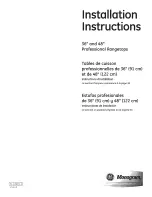
Page GB-17
Cleaning the hob
Cleaning the hob
CAUTION!
Risk of burns!
Improper cleaning can result in burns.
■
Prior to cleaning, allow the hob to cool
completely. Exception: You want to re-
move sugary or starchy food waste, plas-
tics or aluminium foil (see next page).
■
Proceed with caution since the cooking
zones may still be warm even after the
residual heat indicator ‘
H
’ has gone out.
NOTICE
Risk of damage to property!
Improper use of the glass ceramic hob can
cause damages.
■
Do not use steam or high-pressure clean-
ers to clean the hob. Steam could get
through cracks into live electrical com-
ponents of the glass ceramic hob and
cause short-circuiting.
■
Allow the hob to cool completely before
cleaning.
■
Do not use any harsh detergents, scour-
ing agents, abrasive powder or steel
sponges; they can damage the surface.
■
Clean and maintain the hob regularly
with a special care product containing a
special impregnating oil for glass ceram-
ic hobs. Such products can be found in
specialist shops.
Surface stains not permanently burnt
in
1. Switch the hob off.
2. After it has cooled down, wipe light dirt
with a damp cloth.
3. If necessary, use a suitable cleaner and
wipe with clean water.
4. Then dry the surface with a soft cloth to
prevent lime stains.
5. You can easily remove light stains having
a pearlescent colour (aluminium residues,
such as from aluminium foil) using a com-
mercially available detergent that is spe-
cifically available for such cleaning.
6. Vinegar is good for removing lime stains.
Hard, baked-on dirt
1. Tough stains can be most easily removed
after cooling using a blade scraper. The
specially designed cleaning product can
also be found in specialist shops.
2. Finally, wipe the surface with a damp
cloth.
3. Treat the hob with a special care product
after cleaning.
Removing sugary or starchy food
waste, plastics or aluminium foil
NOTICE
Remove sugary or starchy food waste, plas-
tics or aluminium foil immediately. Other-
wise, these may cause permanent and ir-
reparable damage to the hob.
1. If possible, remove residues while hot
from the hot cooking zone surface using
an appropriate scraper.












































